Long-Term Effects of Compost Amendments and Brassica Green Manures in Potato Cropping Systems on Soil and Crop Health and Productivity †
Abstract
1. Introduction
2. Materials and Methods
2.1. Cropping Systems
2.2. Field Set-Up and Management
2.3. Tuber Yield and Size
2.4. Soil Properties
2.5. Disease Assessments
2.6. Statistical Analyses
3. Results
3.1. Tuber Yield
3.2. Disease Assessments
3.3. Soil Properties
4. Discussion
5. Conclusions
Funding
Data Availability Statement
Acknowledgments
Conflicts of Interest
References
- Food and Agriculture Organization of the United Nations (FAO). Food and Agriculture Data 2020. Available online: http://www.fao.org/faostat/en/#home (accessed on 5 May 2022).
- National Agricultural Statistics Service (NASS). State Agricultural Overview for Maine. New England Field Office, Concord, NH, USA. Available online: https://www.nass.usda.gov/Quick_Stats/Ag_Overview/stateOverview.php?state=MAINE (accessed on 5 May 2022).
- Larkin, R.P. Soil health paradigms and implications for disease management. Annu. Rev. Phytopathol. 2015, 53, 199–221. [Google Scholar] [CrossRef] [PubMed]
- Kopittke, P.M.; Menzies, N.W.; Wang, P.; McKenna, B.A.; Lombi, E. Soil and intensification of agriculture for global food security. Environ. Int. 2019, 132, 105078. [Google Scholar] [CrossRef] [PubMed]
- Grandy, A.S.; Porter, G.A.; Erich, M.S. Organic amendment and rotation crop effects on the recovery of soil organic matter and aggregation in potato cropping systems. Soil Sci. Soc. Am. J. 2002, 66, 1311–1319. [Google Scholar] [CrossRef]
- Nyiraneza, J.; Thompson, B.; Geng, X.; He, J.; Jiang, Y.; Fillmore, S.; Stiles, K. Changes in soil organic matter over 18 years in Prince Edward Island, Canada. Can. J. Soil Sci. 2017, 97, 745–756. [Google Scholar] [CrossRef]
- Powell, S.M.; McPhee, J.E.; Dean, G.; Hinton, S.; Sparrow, L.A.; Wilson, C.R.; Tegg, R.S. Managing soil health and crop productivity in potato: A challenging test system. Soil Res. 2020, 58, 697–712. [Google Scholar] [CrossRef]
- Larkin, R.P.; Griffin, T.S.; Honeycutt, C.W. Rotation and cover crop effects on soilborne potato diseases, tuber yield, and soil microbial communities. Plant Dis. 2010, 94, 1491–1502. [Google Scholar] [CrossRef]
- Peters, R.D.; Sturz, A.V.; Carter, M.R.; Sanderson, J.B. Influence of crop rotation and conservation tillage practices on the severity of soil-borne potato diseases in temperate humid agriculture. Can. J. Soil Sci. 2004, 84, 397–402. [Google Scholar] [CrossRef]
- Carter, M.R.; Sanderson, J.B. Influence of conservation tillage and rotation length on potato productivity, tuber disease and soil quality parameters on a fine sandy loam in eastern Canada. Soil Till. Res. 2001, 63, 1–13. [Google Scholar] [CrossRef]
- Mohr, R.M.; Volkmar, K.; Derksen, D.A.; Irvine, R.B.; Khakbazan, M.; McLaren, D.L.; Monreal, M.A.; Moulin, A.P.; Tomasiewicz, D.J. Effect of rotation on crop yield and quality in an irrigated potato system. Am. J. Potato Res. 2011, 88, 346–359. [Google Scholar] [CrossRef]
- Wright, P.J.; Falloon, R.E.; Hedderly, D. A long-term vegetable crop rotation study to determine effects on soil microbial communities and soilborne diseases of potato and onion. N. Z. J. Crop Hortic. Sci. 2017, 45, 29–54. [Google Scholar] [CrossRef]
- Essah, S.Y.C.; Delgado, J.A.; Dillon, M.; Sparks, R. Cover crops can improve potato tuber yield and quality. HortTechnology 2012, 22, 185–190. [Google Scholar] [CrossRef]
- N’Dayegamiye, A.; Nyiraneza, J.; Grenier, M.; Bippfubusa, M.; Drapeau, A. The benefits of crop rotation including cereals and green manure on potato yield and nitrogen nutrition and soil properties. Adv. Crop Sci. Technol. 2017, 5, 279. [Google Scholar] [CrossRef]
- Bernard, E.; Larkin, R.P.; Tavantzis, S.; Erich, M.S.; Alyokhin, A.; Gross, S. Rapeseed rotation, compost, and biocontrol amendments reduce soilborne diseases and increase tuber yield in organic and conventional potato production systems. Plant Soil 2014, 374, 611–627. [Google Scholar] [CrossRef]
- Blanchet, G.; Gavazov, K.; Bragazza, L.; Sinaj, S. Responses of soil properties and crop yields to different inorganic and organic amendments in a Swiss conventional farming system. Agric. Ecosyst. Environ. 2016, 230, 116–126. [Google Scholar] [CrossRef]
- Ninh, H.T.; Grandy, A.S.; Wickings, K.; Snapp, S.S.; Kirk, W.; Hao, J. Organic amendment effects on potato productivity and quality are related to soil microbial activity. Plant Soil 2015, 386, 223–236. [Google Scholar] [CrossRef]
- Rees, H.W.; Chow, T.L.; Zebarth, B.; Xing, Z.; Toner, P.; Lavoie, J.; Daigle, D.L. Impact of supplemental poultry manure application on potato yield and soil properties on a loam soil in north-western New Brunswick. Can. J. Soil Sci. 2014, 94, 49–65. [Google Scholar] [CrossRef]
- Ahmadu, T.; Abdaullahi, A.; Ahmad, K. The role of crop protection in sustainable potato (Solanum tuberosum L.) production to alleviate global starvation: An overview. In Solanum Tuberosum: A Promising Crop for Starvation Problem; Yildiz, Y., Ozgen, Y., Eds.; IntechOpen: London, UK, 2021. [Google Scholar] [CrossRef]
- Devaux, A.; Goffart, J.-P.; Kromann, P.; Andrade-Piedra, J.; Polar, V.; Hareau, G. The potato of the future: Opportunities and challenges in sustainable agri-food systems. Potato Res. 2021, 64, 681–720. [Google Scholar] [CrossRef]
- Larkin, R.P.; Griffin, T.S. Control of soilborne diseases of potato using Brassica green manures. Crop Prot. 2007, 26, 1067–1077. [Google Scholar] [CrossRef]
- Larkin, R.P.; Halloran, J.M. Management effects of disease-suppressive rotation crops on potato yield and soilborne disease and their economic implications in potato production. Am. J. Potato Res. 2014, 91, 429–439. [Google Scholar] [CrossRef]
- Larkin, R.P.; Honeycutt, C.W. Effects of different 3-year cropping systems on soil microbial communities and Rhizoctonia diseases of potato. Phytopathology 2006, 96, 68–79. [Google Scholar] [CrossRef]
- Larkin, R.P.; Honeycutt, C.W.; Griffin, T.S.; Olanya, O.M.; Halloran, J.M.; He, Z. Effects of different potato cropping system approaches and water management on soilborne diseases and soil microbial communities. Phytopathology 2011, 101, 58–67. [Google Scholar] [CrossRef] [PubMed]
- Larkin, R.P.; Honeycutt, C.W.; Griffin, T.S.; Olanya, O.M.; He, Z.; Halloran, J.M. Cumulative and residual effects of different potato cropping system management strategies on soilborne diseases and soil microbial communities over time. Plant Pathol. 2017, 66, 437–449. [Google Scholar] [CrossRef]
- Larkin, R.P.; Honeycutt, C.W.; Griffin, T.S.; Olanya, O.M.; He, Z. Potato growth and yield characteristics under different potato cropping system management strategies in northeastern U.S. Agronomy 2021, 11, 165. [Google Scholar] [CrossRef]
- Larkin, R.P.; Griffin, T.S.; Honeycutt, C.W.; Olanya, M.; He, Z. Potato cropping system management strategy impacts soil physical, chemical, and biological properties over time. Soil Till. Res. 2021, 213, 105148. [Google Scholar] [CrossRef]
- Olanya, O.M.; Honeycutt, C.W.; He, Z.; Larkin, R.P.; Halloran, J.M.; Frantz, J.M. Early and late blight potential on Russet Burbank potato as affected by microclimate, cropping systems, and irrigation management in Northeastern United States. In Sustainable Potato Production: Global Case Studies; He, Z., Larkin, R.P., Honeycutt, C.W., Eds.; Springer: Amsterdam, The Netherlands, 2012; pp. 43–60. [Google Scholar]
- Olanya, O.M.; Larkin, R.P.; Halloran, J.M.; He, Z. Relationships of crop and soil management systems to meteorological variables and potato diseases on a Russet Burbank cultivar. J. Agric. Meteorol. 2014, 70, 91–104. [Google Scholar] [CrossRef]
- He, Z.; Zhang, D.; Zhao, A.; Olanya, O.M.; Larkin, R.P.; Honeycutt, C.W. Quantity and nature of water-extractable organic matter from sandy loam soils with potato cropping management. Agric. Environ. Lett. 2016, 1, 6. [Google Scholar] [CrossRef]
- Gianello, C.; Bremner, J.M. Comparison of chemical methods of assessing potentially available organic nitrogen in soil. Comm. Soil Sci. Plant Anal. 1986, 17, 215–236. [Google Scholar] [CrossRef]
- Helmke, P.A.; Sparks, D.L. Lithium, sodium, potassium, rubidium, and cesium. In Methods of Soil Analysis Part 3: Chemical Methods; Sparks, D.L., Ed.; SSSA Book Series No 5; SSSA: Madison, WI, USA, 1996. [Google Scholar]
- Haney, R.L.; Brinton, W.F.; Evans, E. Soil CO2 respiration: Comparison of chemical titration, CO2 IRGA analysis and the Solvita gel system. Renew. Agric. Food Sys. 2008, 23, 171–176. [Google Scholar] [CrossRef]
- Brinton, W. Proficiency of Solvita CO2-burst and Solvita SLAN in soil testing laboratories. J. Woods End. Lab. 2015, 1, 1–9. [Google Scholar]
- Larkin, R.P. Characterization of soil microbial communities under different potato cropping systems by microbial population dynamics, substrate utilization, and fatty acid profiles. Soil Biol. Biochem. 2003, 35, 1451–1466. [Google Scholar] [CrossRef]
- Shock, C.C.; Feibert, E.B.G.; Saunders, L.D. Potato yield and quality response to deficit irrigation. HortScience 1998, 33, 655–659. [Google Scholar] [CrossRef]
- Zebarth, B.J.; Fillmore, S.; Watts, S.; Barrett, R.; Comeau, L.-P. Soil factors related to within-field variation in commercial potato fields in Prince Edward Island Canada. Am. J. Potato Res. 2021, 98, 139–148. [Google Scholar] [CrossRef]
- Boiteau, G.; Goyer, C.; Rees, H.W.; Zebarth, Z. Differentiation of potato ecosystems on the basis of relationships among physical, chemical and biological soil parameters. Can. J. Soil Sci. 2014, 94, 463–476. [Google Scholar] [CrossRef]
- Sinton, S.M.; Dellow, S.J.; Jamieson, P.D.; Falloon, R.E.; Shah, F.A.; Meenken, E.D.; Richards, K.K.; Michel, A.J.; Tregurtha, C.S.; McCulloch, J.M. Cropping history affects potato yields in Canterbury, New Zealand. Am. J. Potato Res. 2020, 97, 202–213. [Google Scholar] [CrossRef]
- Sinton, S.M.; Falloon, R.E.; Jamieson, P.D.; Meenken, E.D.; Shah, F.A.; Brown, H.E.; Dellow, S.J.; Michel, A.J.; Fletcher, J.D. Yield depression in New Zealand potato crops associated with soil compaction and soil-borne diseases. Am. J. Potato Res. 2022, 99, 160–173. [Google Scholar] [CrossRef]
- Eremeev, V.; Talgre, L.; Kuhnt, J.; Maeorg, E.; Esmaeilzadeh-Salestani, K.; Alaru, M.; Loit, E.; Runno-Parsons, E.; Luik, A. The soil microbial hydrolytic activity, content of nitrogen and organic carbon were enhanced by organic farming management using cover crops and composts in potato cultivation. ACTA Agric. Scand. B Soil Plant Sci. 2020, 70, 87–94. [Google Scholar] [CrossRef]
- Griffin, T.S.; Porter, G.A. Altering soil carbon and nitrogen stocks in intensively tilled two-year rotations. Biol. Fertil. Soils 2004, 39, 366–374. [Google Scholar]
- Nyiraneza, J.; Chen, D.; Fraser, T.; Comeau, L.-P. Improving soil quality and potato productivity with manure and high-residue cover crops in Eastern Canada. Plants 2021, 10, 1436. [Google Scholar] [CrossRef]
- Porter, G.A.; Opena, G.B.; Bradbury, W.B.; McBurnie, J.C.; Sisson, J.A. Soil management and supplemental irrigation effects on potato: I. Soil properties, tuber yield, and quality. Agron. J. 1999, 91, 416–425. [Google Scholar] [CrossRef]
- Wilson, C.; Zebarth, B.J.; Burton, D.L.; Goyer, C. Short-term effects of diverse compost products on soil quality in potato production. Soil Sci. Soc. Am. J. 2018, 82, 889–900. [Google Scholar] [CrossRef]
- Abiven, S.; Menasseri, S.; Chenu, C. The effects of organic inputs over time on soil aggregate stability. Soil Biol. Biochem. 2008, 41, 1–12. [Google Scholar] [CrossRef]
- Albaich, R.; Canet, R.; Pomares, F.; Ingelmo, F. Organic matter components and aggregate stability after application of different amendments to a horticultural soil. Bioresour. Technol. 2001, 76, 125–129. [Google Scholar] [CrossRef]
- Diacono, M.; Montemurro, F. Long-term effects of organic amendments on soil fertility. A review. Agron. Sustain. Dev. 2010, 30, 401–422. [Google Scholar] [CrossRef]
- He, Z.; Tazisong, I.A.; Senwo, Z.N.; Zhang, D. Soil properties and macro cations impacted by long-term applied poultry litter. Comm. Soil Sci. Plant Anal. 2008, 39, 858–872. [Google Scholar] [CrossRef]
- McGuire, A.; Granatstein, G.; Amara, M. An evaluation of soil improvement practices being used on irrigated soils in the Columibia Basin. Wash. State Univ. Ext. Pub. 2017, TB41, 1–8. [Google Scholar]
- Goyer, C.; Neupane, S.; Zebarth, B.J.; Buron, D.L.; Wilson, C.; Sennett, L. Diverse compost products influence soil bacterial and fungal community diversity in a potato crop production system. Appl. Soil Ecol. 2022, 169, 104247. [Google Scholar] [CrossRef]
- Margus, K.; Eremeev, V.; Loit, E.; Runno-Parsons, E.; Maerog, E.; Luik, A.; Talhre, L. Impact of farming system on potato yield and tuber quality in Northern Baltic Sea climate conditions. Agriculture 2022, 12, 568. [Google Scholar] [CrossRef]
- Bonanomi, G.; Lorito, M.; Vinale, F.; Woo, S.L. Organic amendments, benficial microbes, and soil microbiota: Toward a unified framework for disease suppression. Annu. Rev. Phytopathol. 2018, 56, 1–20. [Google Scholar] [CrossRef]
- Jayaraman, S.; Naorem, A.K.; Lal, R.; Dalal, R.C.; Sinha, N.K.; Patra, A.K.; Chaudhari, S.K. Disease-suppressive soils—beyond food production: A critical review. J. Soil Sci. Plant Nutr. 2021, 21, 1437–1465. [Google Scholar] [CrossRef]
- Wilson, C.; Zebarth, B.J.; Burton, D.L.; Goyer, C. Effect of diverse compost products on soilborne diseases of potato. Compost Sci. Util. 2018, 26, 156–164. [Google Scholar] [CrossRef]
- Wilson, C.; Zebarth, B.J.; Burton, D.L.; Goyer, C.; Moreau, G.; Dixon, T. Effect of diverse compost products on potato yield and nutrient availability. Am. J. Potato Res. 2019, 96, 272–284. [Google Scholar] [CrossRef]
- Ma, D.; Yin, L.; Ju, W.; Li, X.; Liu, X.; Deng, X.; Wang, S. Meta-analysis of green manure effects on soil proerties and crop yield in northern China. Field Crops Res. 2021, 266, 108146. [Google Scholar] [CrossRef]
- Morris, E.K.; Fletcher, R.; Veresoglou, S.D. Effective methods of biofumigation: A meta-analysis. Plant Soil 2020, 446, 379–392. [Google Scholar] [CrossRef]
- Chen, D.; Zebarth, B.J.; Goyer, C.; Comeau, L.-P.; Nahar, K.; Dixon, T. Effect of biofumigation on poulation densities of Pratylenchus spp and Verticillium spp. and potato yield in eastern Canada. Am. J. Potato Res. 2022, 99, 229–242. [Google Scholar] [CrossRef]
- Larkin, R.P.; Lynch, R.P. Use and effects of different Brassica and other rotation crops on soilborne diseases and yield of potato. Horticulturae 2018, 4, 37. [Google Scholar] [CrossRef]
- Larkin, R.P. Long-term effects of potato cropping system strategies on soilborne diseases and soil microbial communities. (Abstr.) Phytopathology 2018, 108, S1.163. [Google Scholar] [CrossRef]
- Srour, A.; Larkin, R.P. Harnessing the microbiome of improved potato cropping systems and management practices. (Abstr.) Phytopathology 2021, 111, S2.137. [Google Scholar] [CrossRef]
- Wood, S.A.; Bowman, M. Large-scale farmer-led experiment demonstrates positive impact of cover crops on multiple soil health indicators. Nat. Food 2021, 2, 97–103. [Google Scholar] [CrossRef]
- Carter, M.R.; Holmstrom, D.; Sanderson, J.B.; Ivany, J.A.; DeHaan, R. Comparison of conservation with conventional tillage for potato production in Atlantic Canada: Crop productivity, soil physical properties and weed control. Can. J. Soil Sci. 2005, 85, 453–461. [Google Scholar] [CrossRef]
- Griffin, T.S.; Larkin, R.P.; Honeycutt, C.W. Delayed tillage and cover crop effects in potato systems. Am. J. Potato Res. 2009, 86, 79–87. [Google Scholar] [CrossRef]
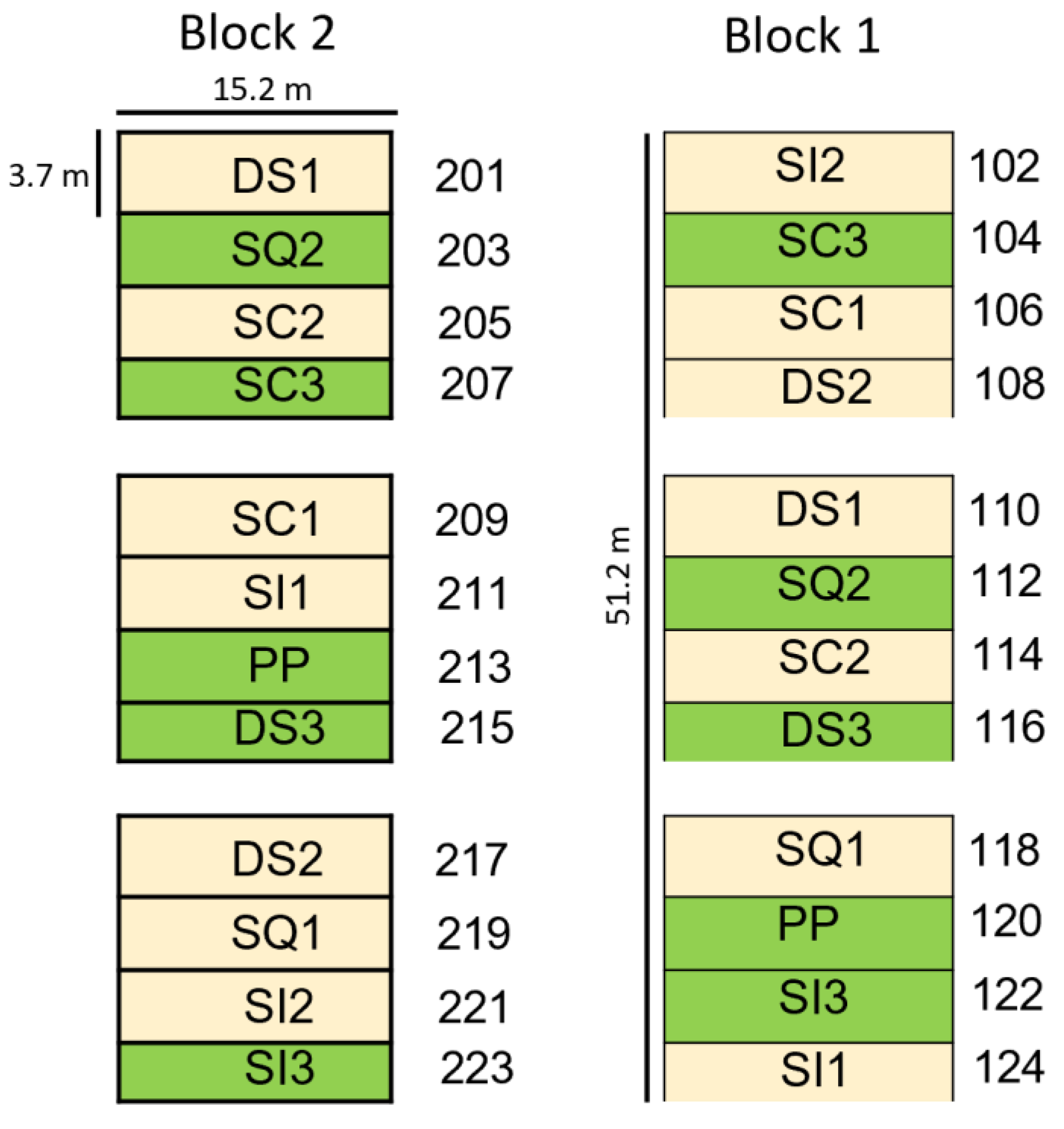
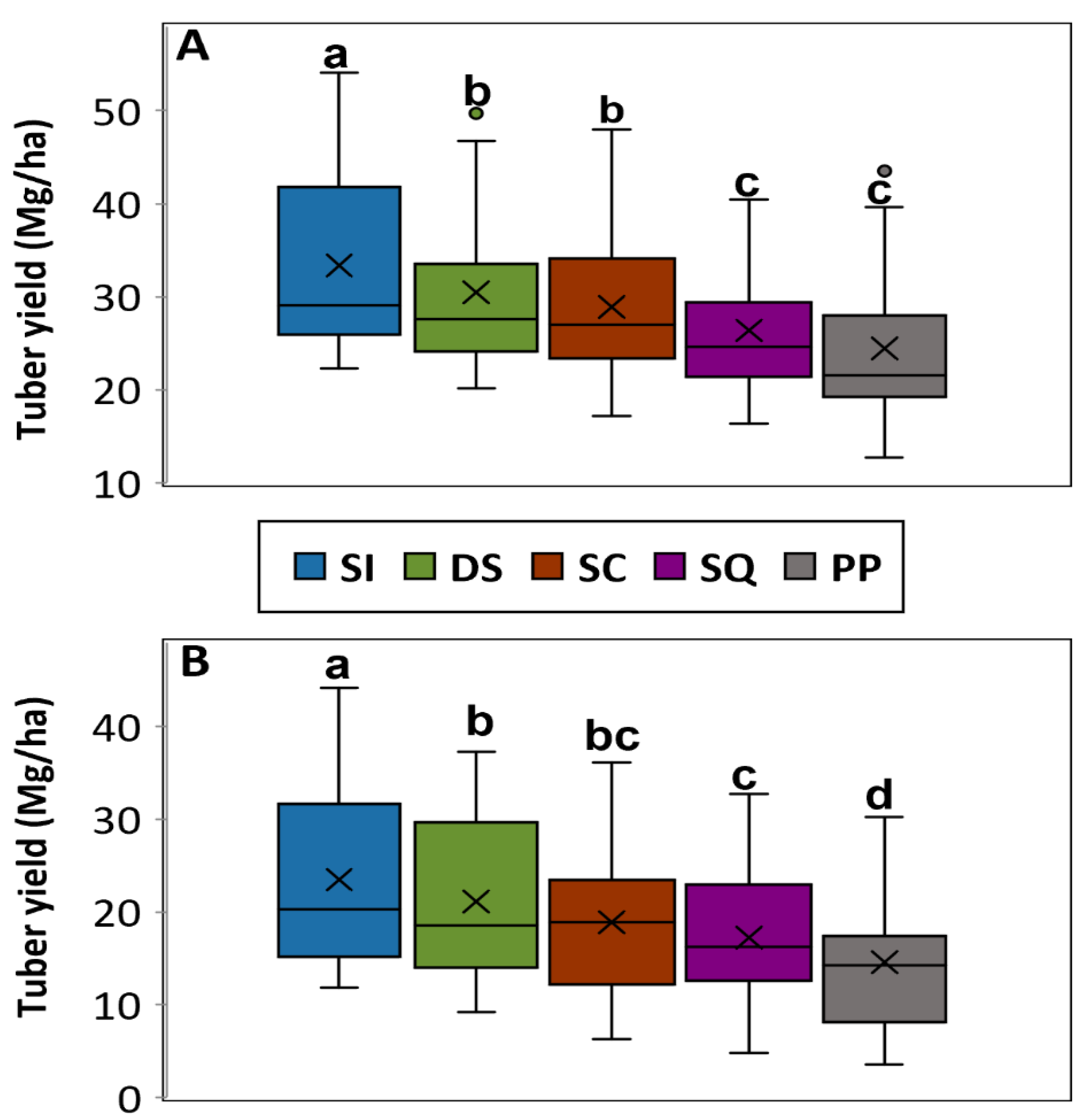
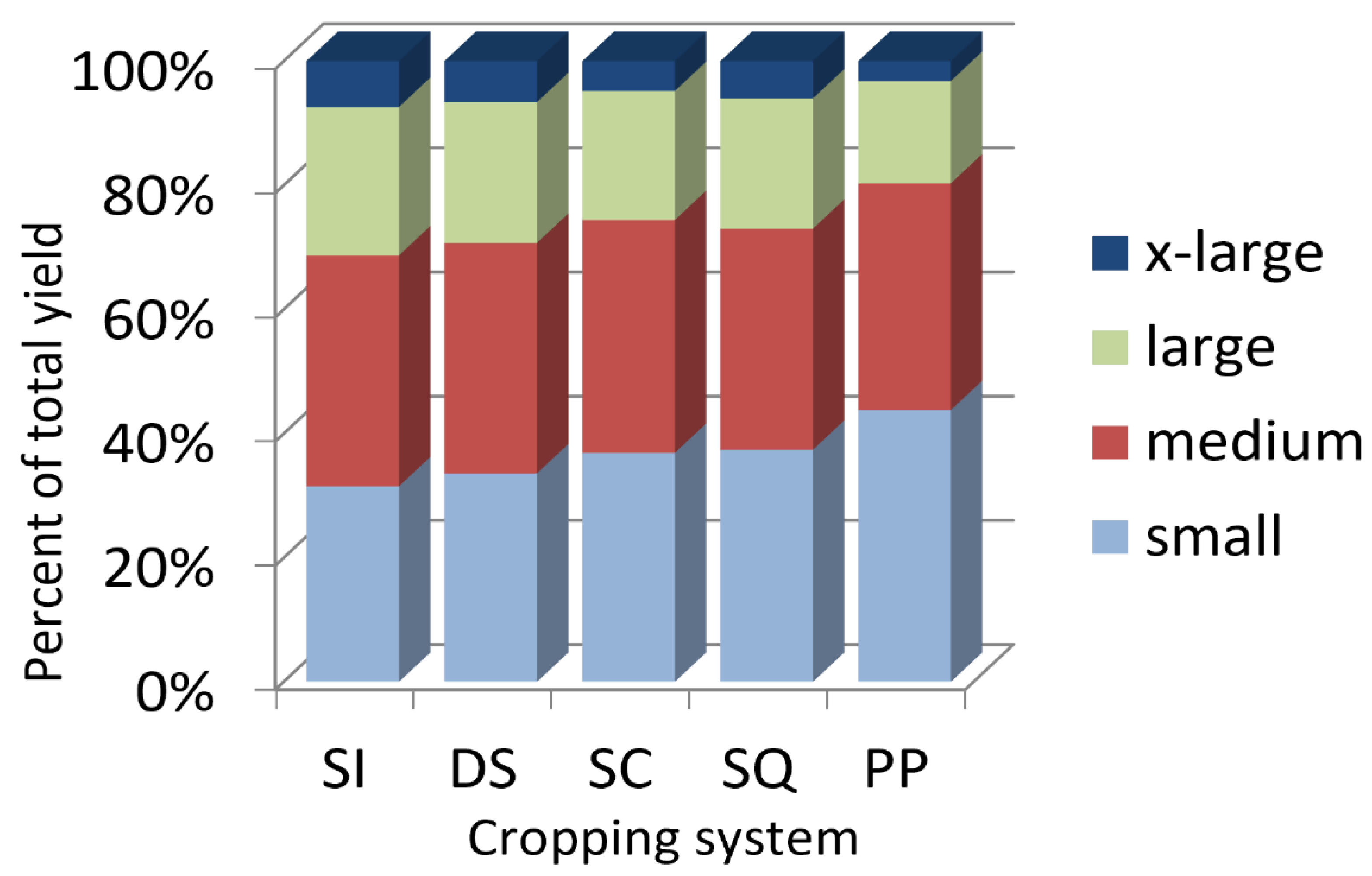
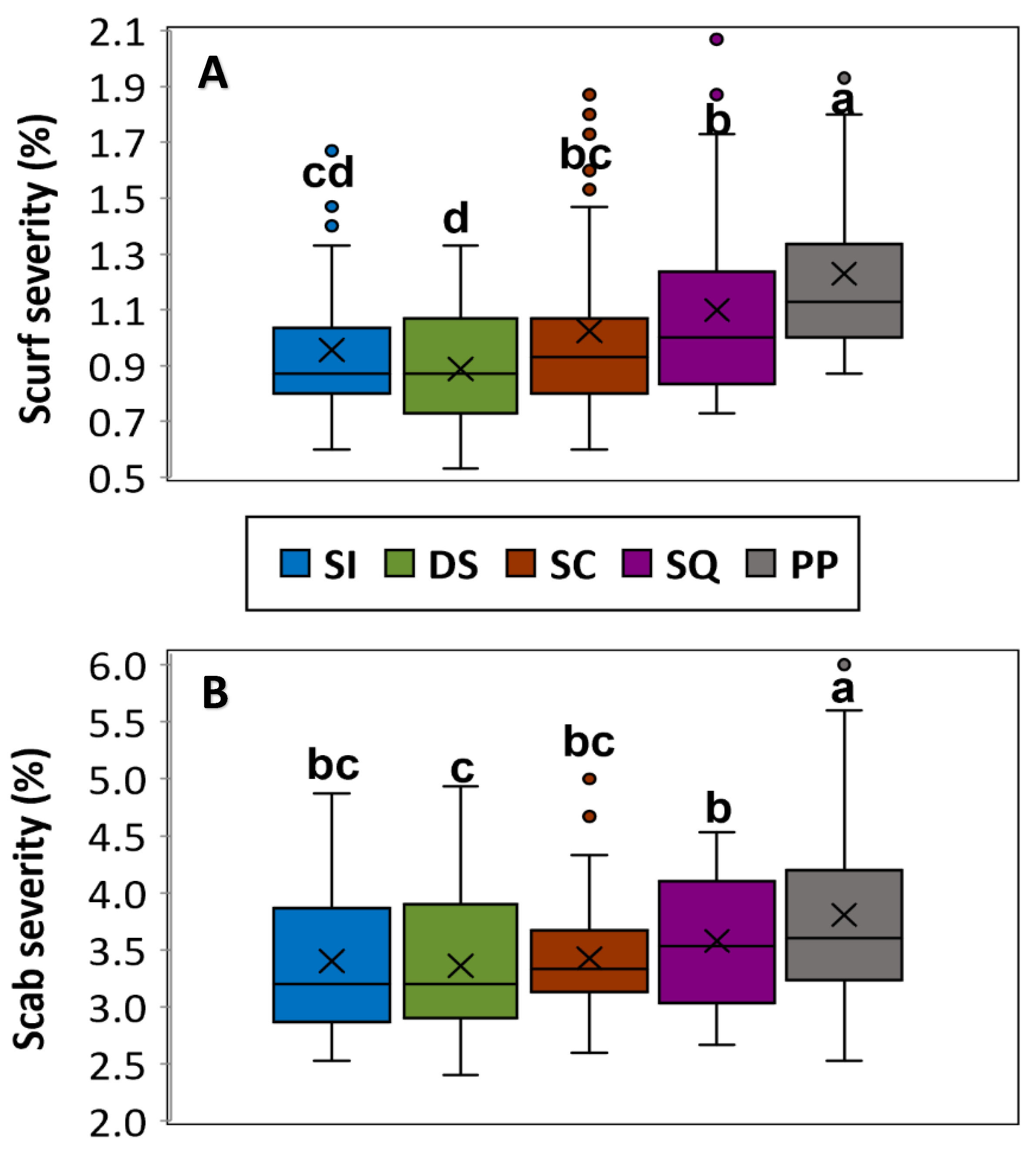
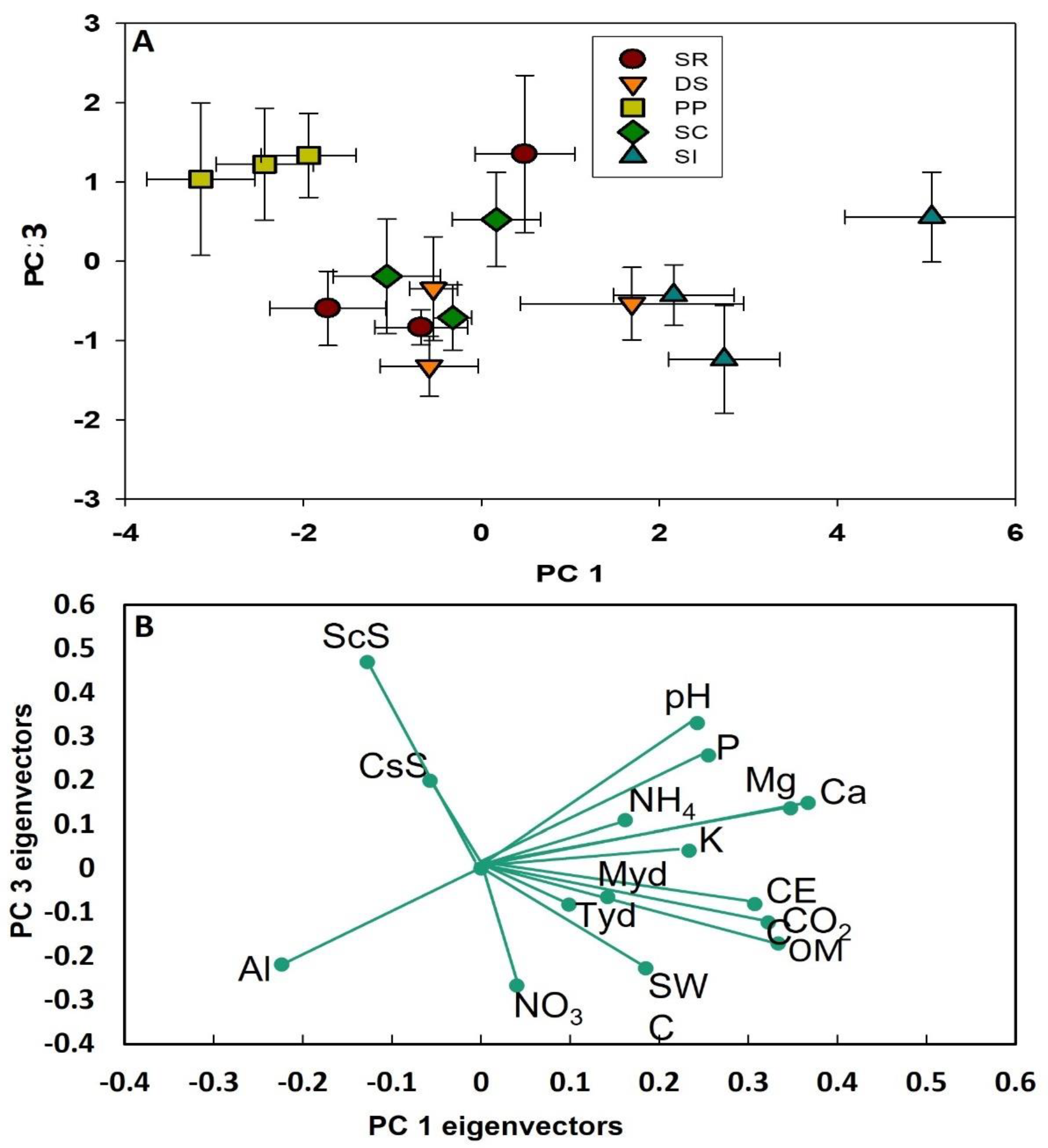
| Cropping System Parameters | ||||
|---|---|---|---|---|
| Name | Designation | Length | Original Rotation (2004–2012) | Modified Rotation (2013–2018)—(Comments) |
| Status Quo | SQ | 2-yr | Barley/Red clover—Potato | No change—Typical rotation (Control) |
| Soil Conserving | SC | 3-yr | Barley/Timothy—Timothy (Limited tillage, straw mulch cover) | Barley/Ryegrass—Canola/winter rye cover (Addition of cash crop) |
| Soil Improving | SI | 3-yr | SC plus compost amendment | Barley/Ryegrass—Canola/winter rye (History of compost) |
| Disease Suppressive | DS | 3-yr | Mustard GM/Rapeseed cover—Sudan grass GM/Rye cover | Barley/Ryegrass—Mustard GM/rapeseed cover (Disease-suppressive green manure and cover crop) |
| Continuous Potato | PP | 1-yr | Potato—Potato | No change—nonrotation control |
| Average Daily Temperature (°C) | Total Monthly Rainfall (cm) | |||||||||
|---|---|---|---|---|---|---|---|---|---|---|
| 2015 | 2016 | 2017 | 2018 | Long-Term Avg | 2015 | 2016 | 2017 | 2018 | Long-Term Avg | |
| May | 14.2 | 12.8 | 11.5 | 12.6 | 11.4 | 7.5 | 6.8 | 11.9 | 4.9 | 8.7 |
| June | 15.0 | 16.5 | 16.5 | 15.8 | 16.4 | 11.4 | 8.7 | 8.9 | 7.6 | 8.6 |
| July | 18.3 | 19.6 | 19.2 | 22.5 | 19.0 | 6.5 | 15.9 | 4.7 | 6.6 | 9.4 |
| August | 20.3 | 19.7 | 18.1 | 20.8 | 18.2 | 8.9 | 12.9 | 4.4 | 8.3 | 10.0 |
| September | 17.1 | 15.4 | 16.8 | 14.7 | 13.2 | 10.4 | 4.6 | 12.9 | 5.6 | 8.7 |
| Season avg | 17.0 | 16.8 | 16.4 | 17.3 | 15.6 | 44.8 | 48.9 | 42.8 | 33.0 | 45.4 |
| Total Tuber Yield (Mg/ha) | Marketable Yield (Mg/ha) | |||||||
|---|---|---|---|---|---|---|---|---|
| System y | 2015 | 2016 | 2017 | 2018 | 2015 | 2016 | 2017 | 2018 |
| SI | 30.1 a z | 49.7 a | 25.7 a | 27.9 a | 21.2 a | 38.9 a | 16.7 a | 17.2 ab |
| DS | 27.1 ab | 42.9 ab | 25.4 a | 26.5 a | 20.1 a | 30.9 b | 13.8 ab | 17.7 a |
| SC | 27.9 ab | 40.4 b | 22.4 ab | 24.9 ab | 18.9 a | 29.0 bc | 11.9 b | 16.0 abc |
| SQ | 25.1 bc | 35.7 b | 21.6 b | 23.0 b | 17.6 ab | 26.0 bc | 11.7 b | 13.4 c |
| PP | 21.9 c | 36.1 b | 17.4 c | 22.4 b | 14.5 b | 23.7 c | 5.9 c | 14.2 bc |
| LSD (p = 0.05) | 4.4 | 6.8 | 3.5 | 3.1 | 4.3 | 7.2 | 3.5 | 3.5 |
| Black Scurf Disease | ||||||||
|---|---|---|---|---|---|---|---|---|
| Incidence (% Infected Tubers) | Severity (% Surface Coverage) | |||||||
| System y | 2015 | 2016 | 2017 | 2018 | 2015 | 2016 | 2017 | 2018 |
| SI | 14.0 b z | 20.7 ab | 4.0 b | 4.0 b | 0.95 b | 1.15 ab | 0.81 bc | 0.86 c |
| DS | 14.6 b | 10.0 c | 4.7 b | 6.0 b | 0.95 b | 0.98 c | 0.71 c | 0.85 c |
| SC | 30.7 a | 10.0 c | 8.7 b | 9.3 b | 1.23 a | 1.01 c | 0.85 b | 0.96 b |
| SQ | 32.7 a | 13.3 bc | 23.3 a | 9.3 b | 1.21 a | 1.04 bc | 1.15 a | 0.96 b |
| PP | 24.7 a | 22.0 a | 22.7 a | 41.3 a | 1.11 a | 1.19 a | 1.19 a | 1.41 a |
| LSD (p = 0.05) | 10.2 | 7.4 | 8.4 | 7.1 | 0.13 | 0.12 | 0.13 | 0.10 |
| Common Scab Disease | ||||||||
|---|---|---|---|---|---|---|---|---|
| Incidence (% Infected Tubers) | Severity (% Surface Coverage) | |||||||
| System y | 2015 | 2016 | 2017 | 2018 | 2015 | 2016 | 2017 | 2018 |
| SI | 38.7 b z | 71.3 b | 27.3 ab | 27.3 bc | 3.48 b | 4.31 b | 3.12 ab | 3.10 bc |
| DS | 46.7 b | 72.7 b | 20.0 b | 22.0 c | 3.55 b | 4.12 b | 2.93 c | 2.95 c |
| SC | 48.0 ab | 68.0 ab | 22.0 b | 35.3 ab | 3.70 ab | 4.20 b | 3.05 bc | 3.24 b |
| SQ | 51.3 ab | 70.0 b | 36.0 a | 29.3 bc | 3.73 ab | 4.21 b | 3.28 a | 3.20 b |
| PP | 61.3 a | 84.7 a | 34.0 a | 42.0 a | 4.02 a | 4.93 a | 3.18 ab | 3.41 a |
| LSD (p = 0.05) | 14.0 | 9.9 | 9.2 | 9.0 | 0.42 | 0.24 | 0.16 | 0.16 |
| Soil Physical Properties x | |||
|---|---|---|---|
| System y | pH | Soil Water (%) | OM (%) |
| SI | 5.99 a z | 20.6 a | 5.65 a |
| DS | 5.96 a | 19.1 b | 4.40 b |
| SC | 5.95 a | 18.2 bc | 4.08 bc |
| SQ | 5.88 ab | 18.3 bc | 3.94 cd |
| PP | 5.82 b | 17.9 c | 3.54 d |
| LSD (p = 0.05) | 0.11 | 1.1 | 0.42 |
| Nutrient Concentrations (mg kg−1 Soil) x | meq 100 g−1 Soil | ||||||
|---|---|---|---|---|---|---|---|
| System y | NO3 | NH4 | P | K | Ca | Mg | CEC |
| SI | 10.6 a z | 4.0 a | 20.2 a | 308.5 a | 1434 a | 283.0 a | 8.4 a |
| DS | 5.7 b | 3.1 bc | 15.0 b | 242.6 bc | 1076 b | 214.7 bc | 7.1 b |
| SC | 6.2 b | 4.1 a | 14.6 b | 215.0 c | 1014 bc | 229.8 b | 6.9 b |
| SQ | 6.4 b | 3.3 b | 16.8 b | 257.6 b | 1019 bc | 189.8 cd | 7.0 b |
| PP | 4.7 b | 2.5 c | 16.5 b | 250.7 bc | 906 c | 164.5 d | 6.7 b |
| LSD (p = 0.05) | 1.6 | 0.66 | 2.6 | 34.8 | 141 | 32.1 | 0.5 |
| Nutrient Concentrations (mg kg−1 Soil) | ||||||||
|---|---|---|---|---|---|---|---|---|
| System y | Mn | Na | S | Fe | Al | Cu | B | Zn |
| SI | 6.27 a z | 10.0 ab | 6.87 a | 5.42 a | 79.1 b | 0.85 b | 0.26 a | 1.00 a |
| DS | 5.43 b | 9.8 b | 5.20 b | 5.08 a | 95.1 a | 1.13 a | 0.18 b | 0.61 bc |
| SC | 5.21 b | 9.3 b | 5.13 b | 5.27 a | 99.4 a | 1.24 a | 0.18 b | 0.47 c |
| SQ | 5.65 b | 10.7 ab | 5.40 b | 5.61 a | 98.7 a | 1.29 a | 0.20 b | 0.67 bc |
| PP | 5.40 b | 11.6 a | 6.40 a | 5.54 a | 104.7 a | 1.17 a | 0.18 b | 0.68 b |
| LSD (p = 0.05) | 0.62 | 1.8 | 0.84 | 0.67 | 11.6 | 0.22 | 0.04 | 0.20 |
| Respiration | Biolog (Substrate Utilization) | Culturable Populations (Dilution Plating) | ||||||
|---|---|---|---|---|---|---|---|---|
| System y | CO2 | AWCD | Richness | Diversity | Bacteria | Fungi | Tricho. | Penicil. |
| (ppm) | (absorbance) | (#) | (Index) | (×106) | (×104) | (×104) | (×104) | |
| SI | 141.1 a z | 0.564 a | 58.2 a | 4.12 ab | 58.5 a | 38.5 a | 1.80 ab | 0.62 bc |
| DS | 119.6 b | 0.484 b | 57.6 ab | 4.13 a | 55.4 a | 36.1 a | 1.78 ab | 0.47 c |
| SC | 103.6 c | 0.515 b | 57.1 b | 4.11 ab | 48.4 b | 29.8 b | 1.88 a | 0.91 bc |
| SQ | 97.7 c | 0.499 b | 57.3 ab | 4.10 b | 56.9 a | 37.7 a | 1.23 b | 1.26 b |
| PP | 56.8 d | 0.438 c | 53.8 c | 4.03 c | 37.1 c | 38.9 a | 0.58 c | 6.13 a |
| LSD (p = 0.05) | 15.9 | 0.034 | 1.0 | 0.03 | 5.6 | 4.6 | 0.55 | 0.64 |
Publisher’s Note: MDPI stays neutral with regard to jurisdictional claims in published maps and institutional affiliations. |
© 2022 by the author. Licensee MDPI, Basel, Switzerland. This article is an open access article distributed under the terms and conditions of the Creative Commons Attribution (CC BY) license (https://creativecommons.org/licenses/by/4.0/).
Share and Cite
Larkin, R.P. Long-Term Effects of Compost Amendments and Brassica Green Manures in Potato Cropping Systems on Soil and Crop Health and Productivity. Agronomy 2022, 12, 2804. https://doi.org/10.3390/agronomy12112804
Larkin RP. Long-Term Effects of Compost Amendments and Brassica Green Manures in Potato Cropping Systems on Soil and Crop Health and Productivity. Agronomy. 2022; 12(11):2804. https://doi.org/10.3390/agronomy12112804
Chicago/Turabian StyleLarkin, Robert P. 2022. "Long-Term Effects of Compost Amendments and Brassica Green Manures in Potato Cropping Systems on Soil and Crop Health and Productivity" Agronomy 12, no. 11: 2804. https://doi.org/10.3390/agronomy12112804
APA StyleLarkin, R. P. (2022). Long-Term Effects of Compost Amendments and Brassica Green Manures in Potato Cropping Systems on Soil and Crop Health and Productivity. Agronomy, 12(11), 2804. https://doi.org/10.3390/agronomy12112804







